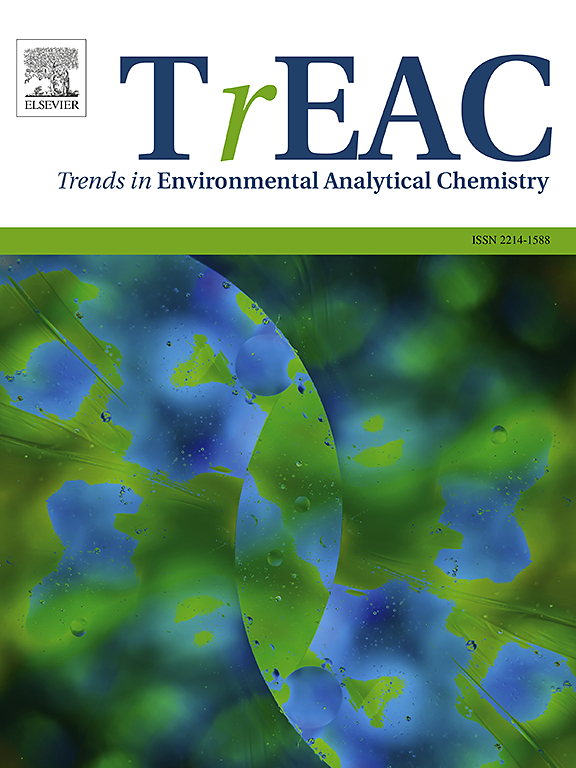Latest advances in environmental applications of COFs and their derivatives towards marine biotoxins
IF 13.4
2区 化学
Q1 CHEMISTRY, ANALYTICAL
引用次数: 0
Abstract
Marine biotoxins pose persistent threats to aquatic ecosystems and food safety, calling for advanced monitoring and remediation strategies. This review highlights covalent organic frameworks (COFs) as multifunctional materials for toxin sensing, adsorption, and catalytic degradation under marine conditions. Key advances in framework design, including pore engineering, surface functionalization, and hybridization, are summarized to illustrate how structural control enhances toxin-specific recognition. Representative applications targeting saxitoxin, domoic acid, okadaic acid, and microcystins are highlighted. COF adsorbents show high capacities for lipophilic shellfish toxins (e.g., okadaic acid/dinophysistoxin-1 up to 812/830 mg g⁻¹) and ultrafast adsorption for polar analytes (e.g., domoic acid reaching 66.5 mg g⁻¹ within 7 min), while retaining > 80 % efficiency after multiple regeneration cycles. COF-based sensors achieve detection limits as low as pg mL⁻¹ in seawater and 0.005 µg kg⁻¹ in shellfish. Moreover, mechanistic insights into pseudo-second-order adsorption kinetics, Freundlich/Langmuir isotherms, binding forces (π–π conjugation, hydrogen bonding, electrostatic, and hydrophobic interactions), and key signal transduction pathways (photoinduced electron transfer (PET), fluorescence resonance energy transfer (FRET)) are critically discussed, together with COF-based photocatalytic systems enabling ROS (•OH, 1O2, and O2•⁻)-driven degradation of recalcitrant toxins. Despite these advances, challenges remain regarding scalability, long-term stability, and field deployment. Future opportunities include machine learning-guided COF design, integrated sensing–remediation systems, and alignment with regulatory standards, providing a roadmap toward next-generation solutions for marine toxin management.
COFs及其衍生物在海洋生物毒素方面环境应用的最新进展
海洋生物毒素对水生生态系统和食品安全构成持续威胁,需要先进的监测和补救战略。本文综述了共价有机框架(COFs)作为海洋条件下毒素传感、吸附和催化降解的多功能材料。概述了框架设计的关键进展,包括孔隙工程,表面功能化和杂交,以说明结构控制如何增强毒素特异性识别。重点介绍了针对蛤蚌毒素、软骨藻酸、冈田酸和微囊藻毒素的代表性应用。COF吸附剂对亲脂性贝类毒素(例如,冈田酸/甲藻毒素-1高达812/830 mg g⁻¹)的吸附能力很强,对极性分析物(例如,7 min内达到66.5 mg g⁻¹)的吸附能力很强,在多次再生循环后仍保持 80 %的效率。基于cof的传感器在海水中的检测限低至pg mL⁻¹ ,在贝类中的检测限低至0.005 µg kg⁻¹ 。此外,伪二级吸附动力学、Freundlich/Langmuir等温线、结合力(π -π共轭、氢键、静电和疏水相互作用)和关键的信号转导途径(光诱导电子转移(PET)、荧光共振能量转移(FRET))的机理深入讨论,以及基于cof的光催化系统,使ROS(•OH、1O2和O2•毒化)驱动降解顽固毒素。尽管取得了这些进步,但在可扩展性、长期稳定性和现场部署方面仍然存在挑战。未来的机会包括机器学习引导的COF设计,集成传感修复系统,以及与监管标准的一致性,为下一代海洋毒素管理解决方案提供路线图。
本文章由计算机程序翻译,如有差异,请以英文原文为准。
求助全文
约1分钟内获得全文
求助全文
来源期刊

Trends in Environmental Analytical Chemistry
Chemistry-Analytical Chemistry
CiteScore
21.20
自引率
2.70%
发文量
34
审稿时长
44 days
期刊介绍:
Trends in Environmental Analytical Chemistry is an authoritative journal that focuses on the dynamic field of environmental analytical chemistry. It aims to deliver concise yet insightful overviews of the latest advancements in this field. By acquiring high-quality chemical data and effectively interpreting it, we can deepen our understanding of the environment. TrEAC is committed to keeping up with the fast-paced nature of environmental analytical chemistry by providing timely coverage of innovative analytical methods used in studying environmentally relevant substances and addressing related issues.
 求助内容:
求助内容: 应助结果提醒方式:
应助结果提醒方式:


